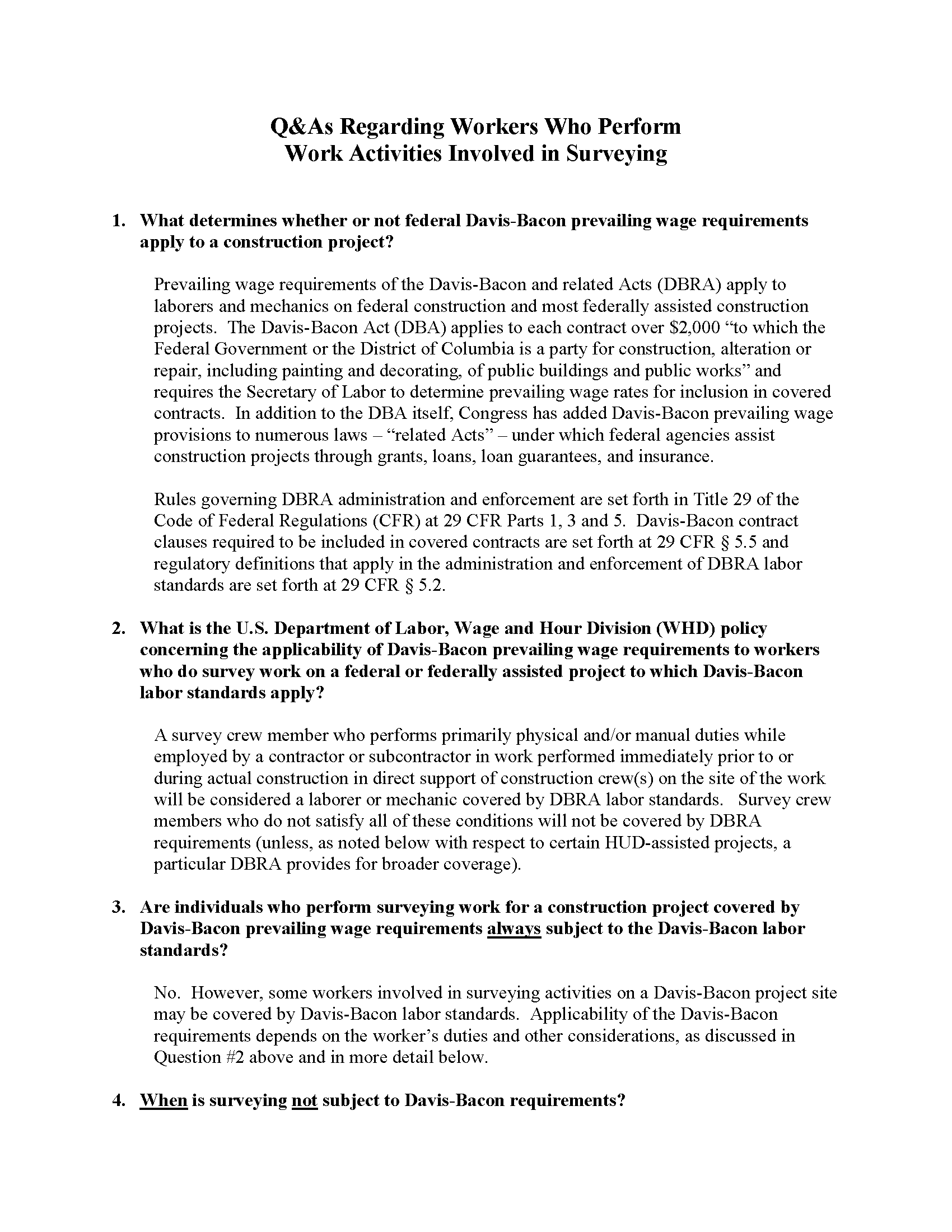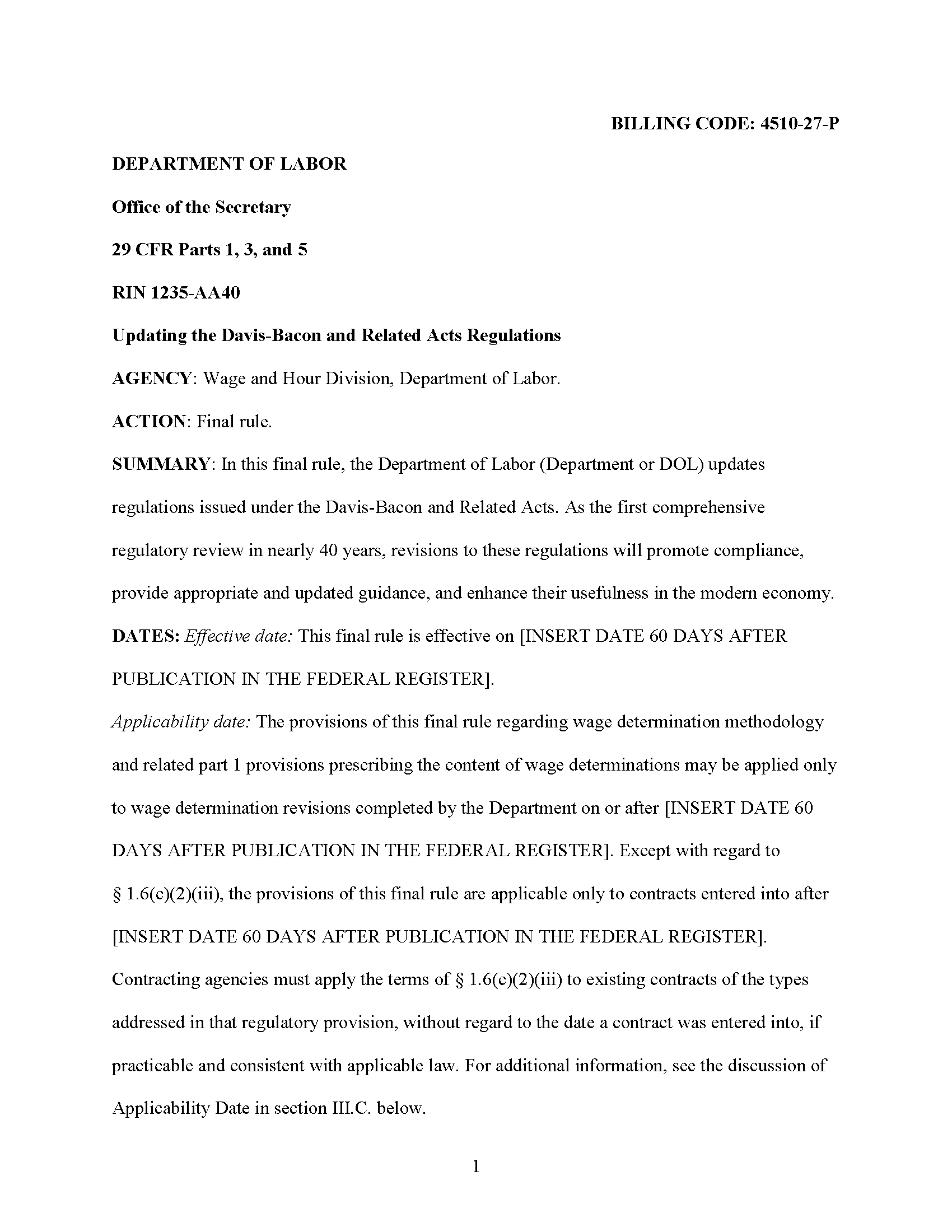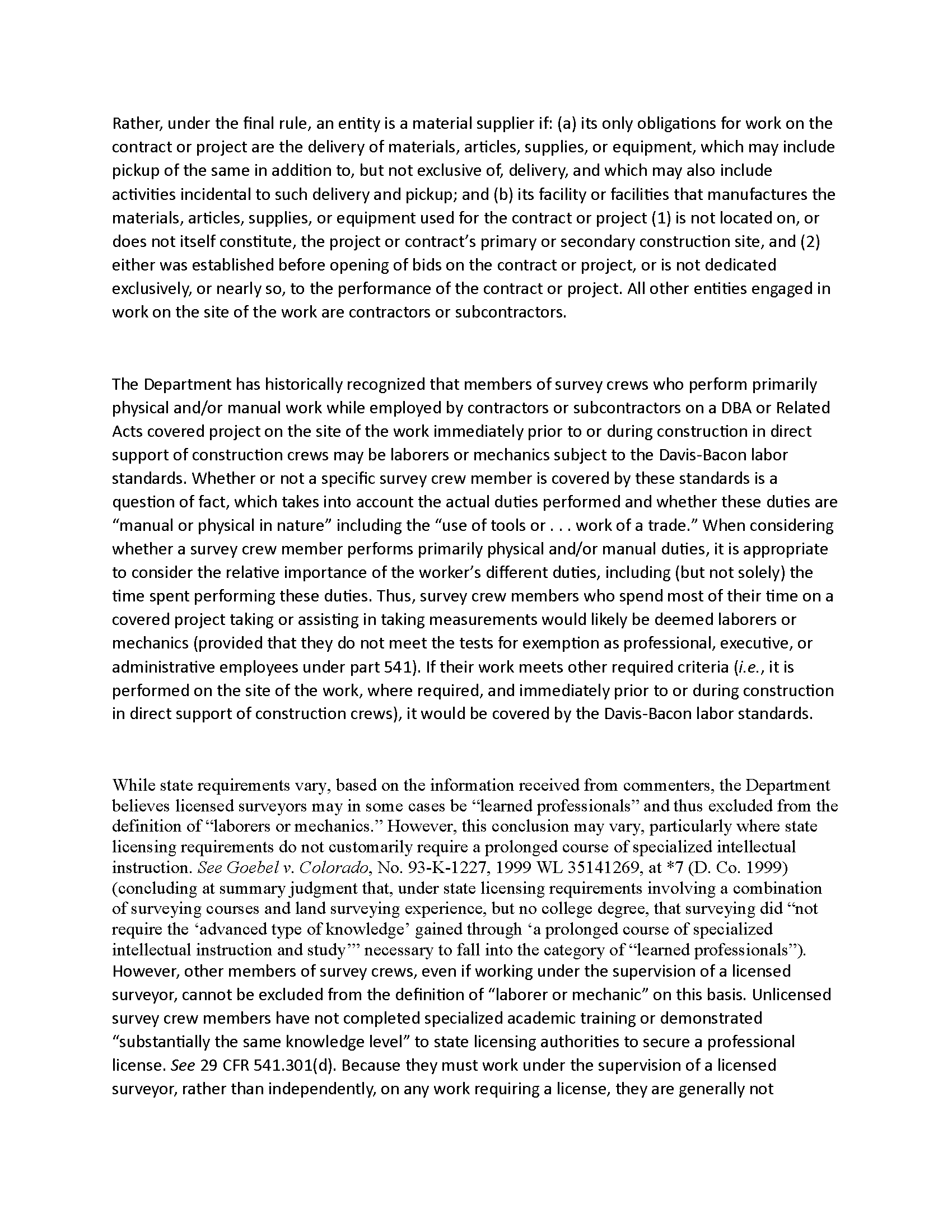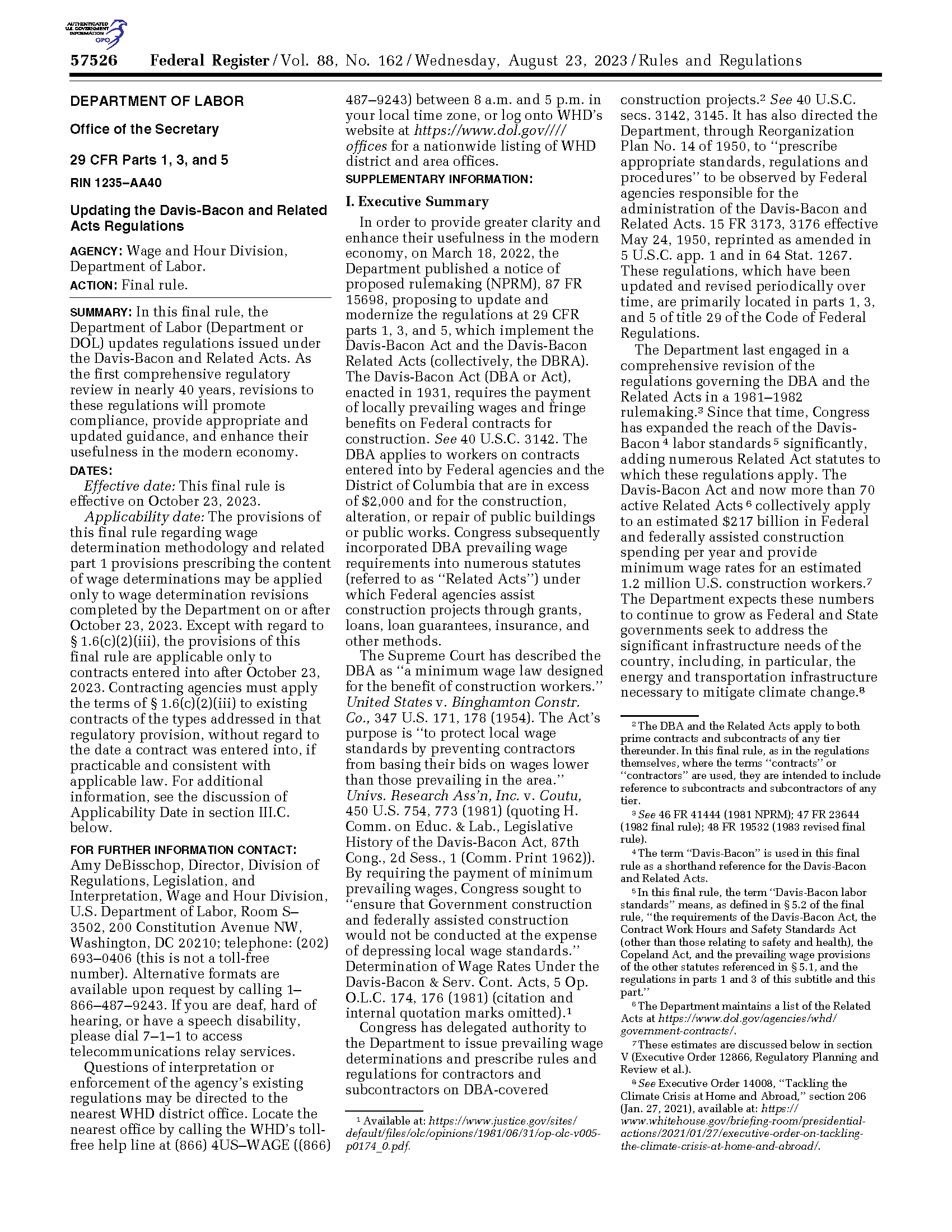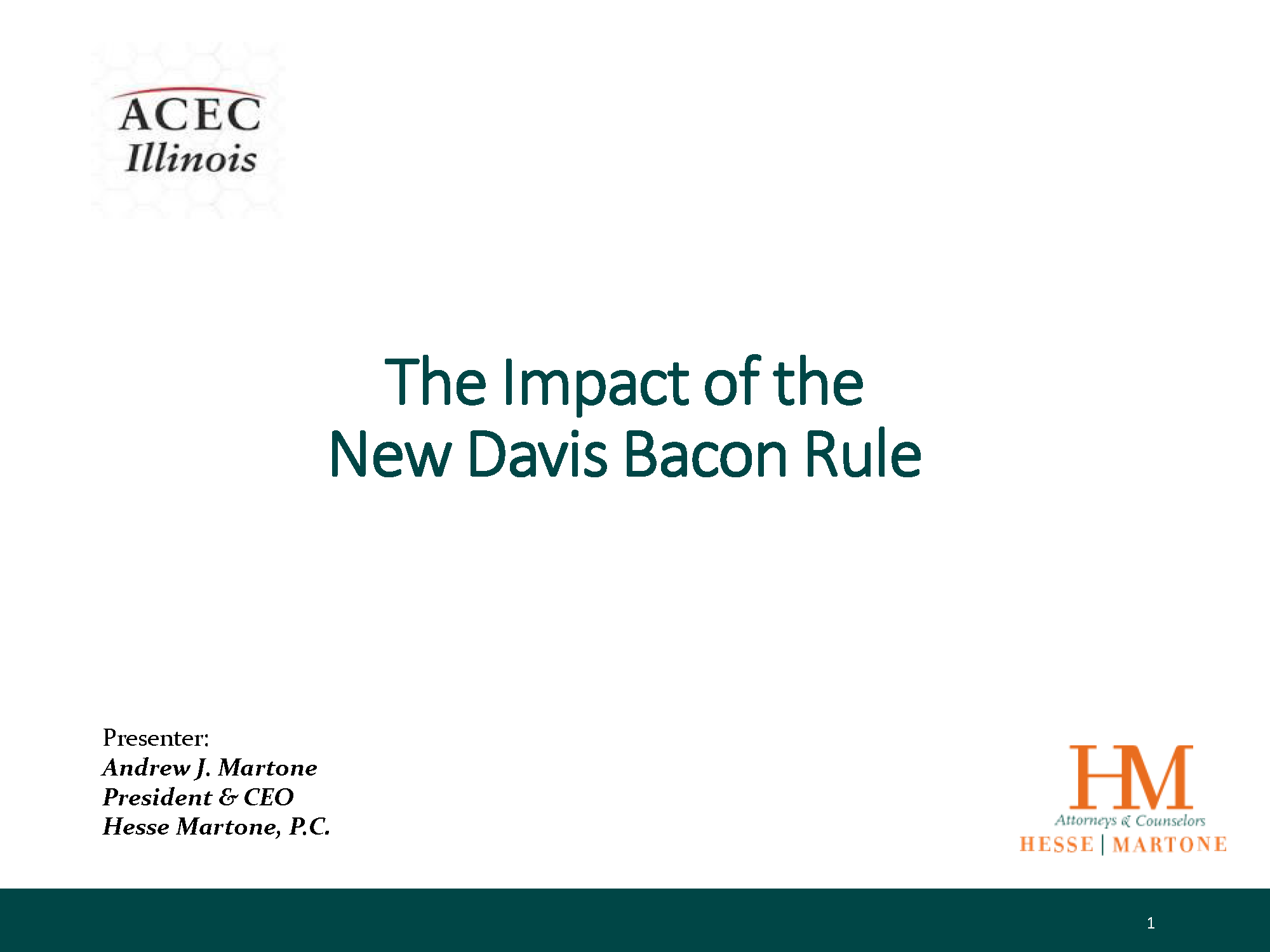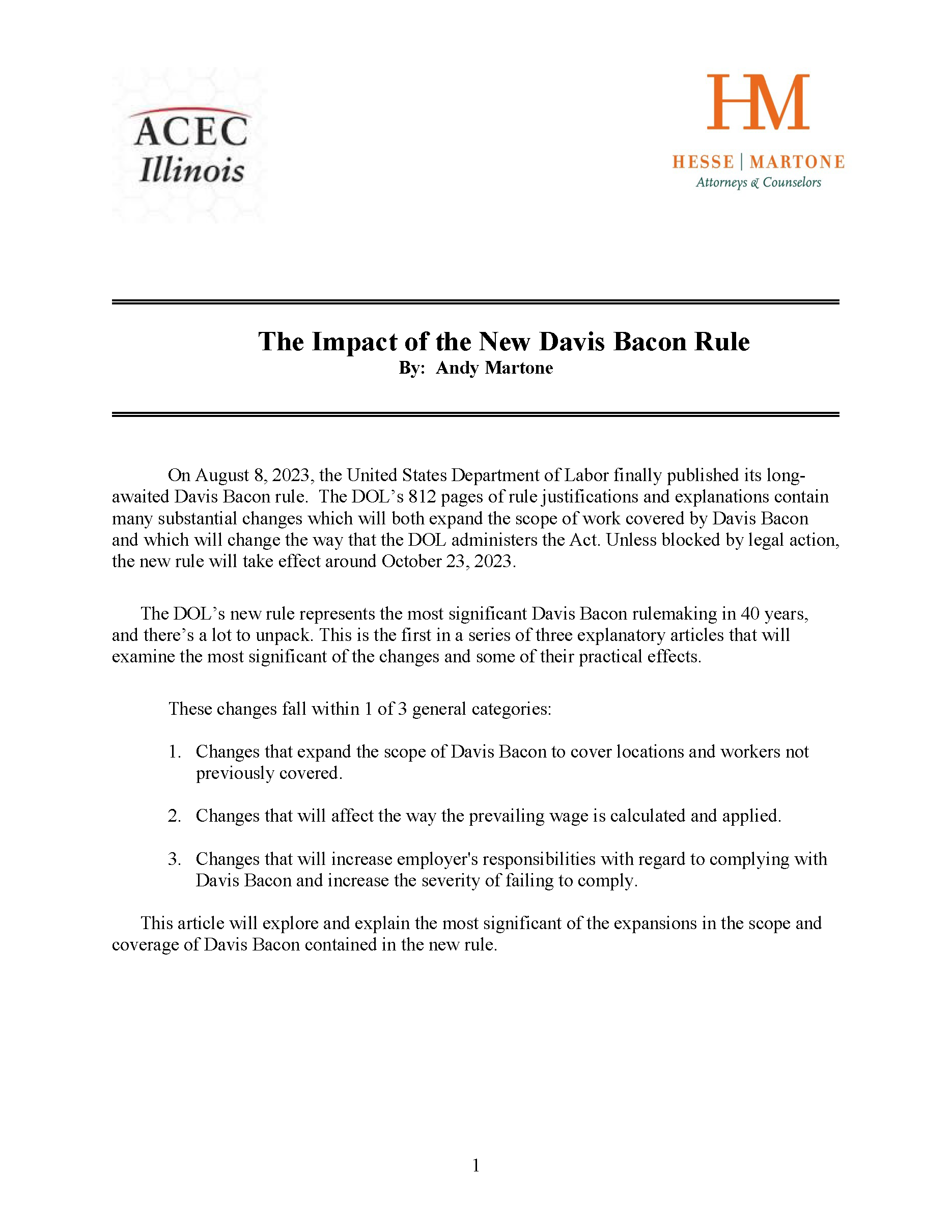Questions & Answers about the Davis-Bacon Act & Surveyors in 2023.
Click on full documents available for more information, this page.
How does the Department of Labor determine the pay of labor trades on their projects? The “prevailing wages” are determined based on wages paid to various classes of laborers and mechanics employed on specific types of construction projects in an area.
What federal projects are required to have Davis-Bacon labor rates? The Davis-Bacon Act applies to each federal government or District of Columbia contract in excess of $2,000 for the construction, alteration, or repair (including painting and decorating) of public buildings or public works. Many federal laws that authorize federal assistance for construction through grants, loans, loan guarantees, and insurance are Davis-Bacon “Related Acts.” The “Related Acts” include provisions that apply Davis-Bacon labor standards to most federally assisted construction. Examples of “Related Acts” include the Federal-Aid Highway Acts, the Housing and Community Development Act of 1974, and the Federal Water Pollution Control Act.
How does the Davis-Bacon Act apply to federal projects? Contractors and subcontractors must pay laborers and mechanics employed directly upon the site of the work at least the locally prevailing wages (including fringe benefits), listed in the Davis-Bacon wage determination in the contract, for the work performed. Davis-Bacon labor standards clauses must be included in covered contracts.
What is the U.S. Department of Labor, Wage and Hour Division (WHD) policy concerning the applicability of Davis-Bacon prevailing wage requirements to workers who do survey work on a federal or federally assisted project to which Davis-Baconlabor standards apply? A survey crew member who performs primarily physical and/or manual duties while employed by a contractor or subcontractor in work performed immediately prior to or during actual construction in direct support of construction crew(s) on the site of the work will be considered a laborer or mechanic covered by DBRA labor standards. Survey crew members who do not satisfy all of these conditions will not be covered by DBRA requirements (unless, as noted below with respect to certain HUD-assisted projects, a particular DBRA provides for broader coverage).
Are individuals who perform surveying work for a construction project covered byDavis-Bacon prevailing wage requirements always subject to the Davis-Bacon laborstandards? No. However, some workers involved in surveying activities on a Davis-Bacon project site may be covered by Davis-Bacon labor standards. Applicability of the Davis-Bacon requirements depends on the worker’s duties and other considerations.
Note: The ILPLSA recommends to describe the activites of your Davis-Crew members if not all qualify for the labor rate. If a crew member’s role is just for assistance of the equipment to work, without performing surveying mathematical and physical activites, this person may be exempt. Typically this could be a rod-person or helper.
When is surveying not subject to Davis-Bacon requirements? Generally, workers engaged in surveying work during the design phase for a construction project, whose work is used by the architect or engineering firm responsible for developing design plans and specifications for the project before the construction contract is awarded are not subject to Davis-Bacon requirements; as such preliminary survey work is not a part of construction.
Similarly, on a design-build contract, workers engaged in surveying work that is conducted to serve the project design work being conducted by the architect or engineering firm would not be covered by the Davis-Bacon labor standards.
Note regarding certain HUD-assisted projects: Due to specific language in the Davis-Bacon related Act provisions in the United States Housing Act of 1937 and the Housing Actof 1949, application of a “development of the project” coverage test to construction projectsassisted under these laws can be broader and may also result in DBRA coverage ofpreliminary survey work. – Surveying for a residential project that may become a hud project, may require that the construction was done according to the Davis-Bacon Act. How will this even be possible to know?
Why are survey crews classified as Laborers and Mechanics in the December, 2022 Davis-Bacon Act revision? The term laborer or mechanic includes at least those workers whose duties are manual or physical in nature (including those workers who use tools or who are performing the work of a trade), as distinguished from mental or managerial. … The term does not apply to workers whose duties are primarily administrative, executive, or clerical, rather than manual. Persons employed in a bona fide executive, administrative, or professional capacity as defined in part 541 of this title are not deemed to be laborers or mechanics. Working foremen who devote more than 20 percent of their time during a workweek to mechanic or laborer duties, and who do not meet the criteria of part 541, are laborers and mechanics for the time so spent.
Click on full documents available for more information, this page.
Thank you to the ILPLSA for being on top of this issue, seeking out legal advice and providing the support and documentation for surveyors to use going forward.
There is another classification for Professional Surveyors (OSHA & the Bureau of Labor Statistics) which should be known to Professional Surveyors:
Despite the ruling of the Department of Labor to include survey crew members in the Davis-Bacon Act, Professional Surveyors should be aware that the North American Industry Classification System (NAICS), which is defined by the BLS, identifies Surveying & Mapping (Except Geophysical Services) Services as code 541370, which is a sub-category of Architectural, Engineering, and Related Services – NAICS Code 5413. Civil Engineering specifically is NAICS 541330.
This classification is/has been required for federal projects, USACE projects, SAM.gov & FBO projects. You cannot exist as a professional survey (or engineering) firm without identifying as this NAICS code in federal systems and project databases, also used with municipal codes and requirements used nationally.
Partially Exempt Industries list (here: https://www.osha.gov/recordkeeping/presentations/exempttable). Architectural, Engineering, and Related Services – NAICS Code 5413 – do not need to track OSHA records.
From the DOL website: Employers are not required to keep OSHA injury and illness records for any establishment classified in the following North American Industry Classification System (NAICS), unless they are asked in writing to do so by OSHA, the Bureau of Labor Statistics (BLS), or a state agency operating under the authority of OSHA or the BLS. All employers, including those partially exempted by reason of company size or industry classification, must report to OSHA any workplace incident that results in a fatality, in-patient hospitalization, amputation, or loss of an eye (see § 1904.39).
OSHA and the NAICS structure for professional services, recognize surveying as this, a professional service.
